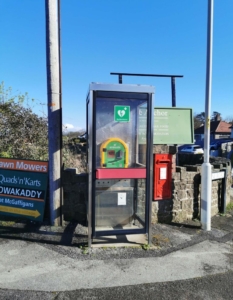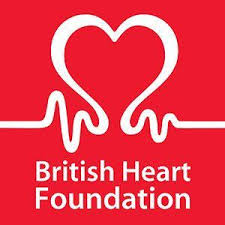
New Defibrillator for the Village of Bolton-le-Sands
A new defibrillator is available in the village. The Bolton-le-Sands Parish Council say:
“We are delighted to announce the installation of a new defibrillator at the South end of the village. This addition increases the total number of defibrillators in Bolton le Sands to 4. The new defibrillator, sponsored by the BLS Women’s Institute and BLS Parish Council, can be found in the old phone box situated on the corner of Slyne Road and Bypass Road, across from Broadlands Drive.”
Defibrillator Locations:
Slyne Road Phone box on the corner of Slyne Road and Bypass Road, opposite Broadlands Drive. Available 24 hours. Funded by the Women’s Institute BLS and BLS Parish Council
Sands News, Coastal Road Garage, Bolton le Sands. Available 24hrs. Funded by the Women’s Institute BLS.
Outside the Community Centre Bolton le Sands Available 24hrs.
Funded by the Community Centre and BLS Parish Council.
Outside Brookfield (Ash Trees) Doctors Surgery A6 Bolton le Sands Available 24hrs.
Funded by Carnforth Rotary Club.
Other nearby defibrillators
Archers Café Red Bank Farm, The Shore, Bolton le Sands. Available 24hrs.
Morecambe Lodge Farm, Shore Lane, Bolton le Sands. Available 24hrs.
Outside the entrance to St. Luke’s Primary School Slyne with Hest. Available 24hrs.
Funded by Slyne with Hest Primary School Rota Kids Project.
Outside the entrance to the Community Centre Slyne with Hest. Available 24hrs.
Funded by the Community Centre.
What is a defibrillator
A defibrillator is a device that gives a jolt of energy to the heart. It helps get the heart beating again when someone is in cardiac arrest and their heart has stopped. You might also hear it being called a defib, a PAD (public access defibrillator) or an AED (automated external defibrillator).
How to use a defibrillator
If someone is in cardiac arrest, call 999 and start CPR. If you’re on your own, do not interrupt CPR to go and find a defibrillator. If it’s possible, send someone else to find one. When you call 999, the operator can tell you if there’s a public access defibrillator nearby.
Anyone can use a defibrillator. You do not need training. Once you turn it on, it will give clear step-by-step voice instructions.
Many defibrillators also have visual prompts and images showing how to use it.
The device checks the person’s heart rhythm and will only tell you to give them a shock if it’s needed. You cannot shock yourself or someone else accidentally.
Steps to using a defibrillator
Step 1: Press the green button to switch on the defibrillator and follow the instructions.
Step 2: Remove the person’s clothing above the waist.
You might have to remove a person’s bra by slipping the straps down or cutting it off. Most defibrillator packs have tools like scissors to help you to do this. It might feel odd or embarrassing but do not let that stop you. Remember, this is a life-or-death situation.
Step 3: Peel off the sticky pads and attach them to the person’s bare skin. Put one pad on each side of the chest as shown in the picture on the defibrillator.
Step 4: Once you have attached the pads, stop CPR and do not touch the person. The defibrillator will then check the person’s heart rhythm.
Step 5: The defibrillator will decide whether a shock is needed. If so, it will tell you to press the ‘shock’ button. An automatic defibrillator will shock the person without you needing to do anything. Do not touch the person while they’re being shocked.
Step 6: The defibrillator will tell you when the shock has been given and whether you need to continue CPR.
Step 7: If the defibrillator tells you to continue to do CPR, continue with chest compressions until the person shows signs of life, or the defibrillator tells you to stop so it can analyse the heartbeat again.
Watch the video that tells you what a defibrillator is and how to use it. Click on image below:








